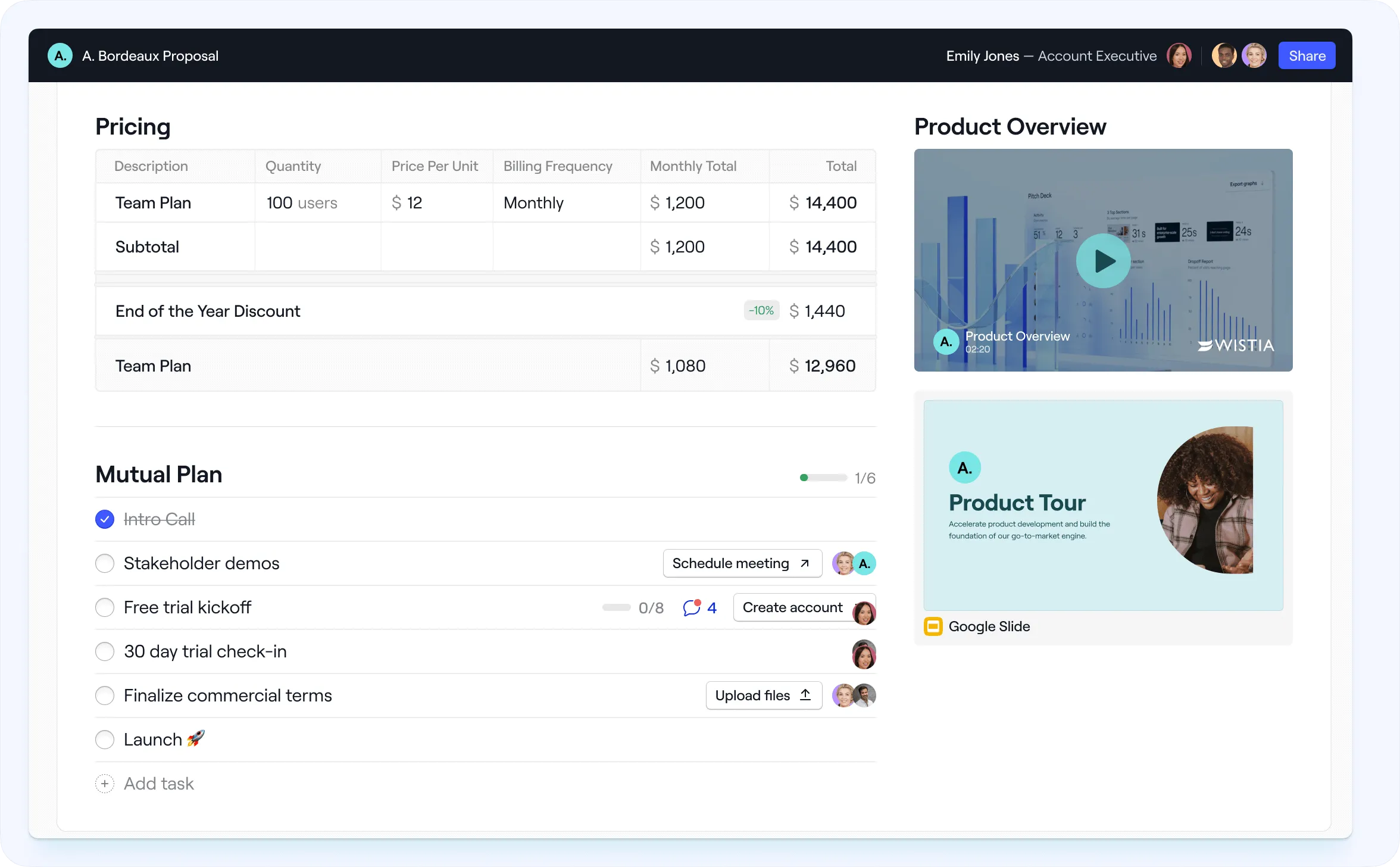Product
TABLE OF CONTENTs
TABLE OF CONTENT
Sales is a lot more like project management than you think. Nearly every B2B sales process involves:
- Gathering client requirements
- Uncovering stakeholders
- Identifying risks
- Establishing shared goals
- Making a business case
These are all project management 101 concepts. But let’s be real here for a second:
Most salespeople (even the best ones) are not planners. They default to action. They’re successful precisely because they’re so good at reading the room and reacting quickly.
But as the B2B buyer journey gets more complex—with more stakeholders, more stringent technical requirements, and fewer opportunities for sales conversations—every sales rep can benefit from thinking more like a project manager.
In this guide, we’ve compiled a few best practices that sales leaders can immediately take back to their team.
What is sales project management?
Sales project management is a system for applying project management best practices to the sales process.
In industries with lengthy sales processes (e.g., enterprise SaaS), taking a project management approach to sales helps anticipate and avoid deal roadblocks over the course of the sales cycle.
Sales project management allows teams to:
- Create a single source of truth for both buyers and sellers
- Establish a list of key stakeholders
- Clarify the timeline of action steps
- Plan around budgets
- Communicate progress and/or issues
- Address blockers as they come up
The ultimate goal of sales project management is to create more predictability for sellers and sales leaders. It helps sales leaders stay on top of deal progress, find solutions to problems, adjust to buyer needs, and communicate quickly.
How is sales becoming more like project management?
The B2B buyer journey has become way more complex, so sellers have to adapt.
You’ve surely seen this Gartner graphic by now:

Because buying has become so complicated, it’s the seller’s job to make the process simpler for the buyer (i.e., buyer enablement).
One way to go about this is to take a project management approach to sales.
There are many aspects of project management that overlap with the sales process — and where compounding principles and best practices of both can become a major competitive advantage.
For instance:
- Planning: Sales teams need to plan their sales process carefully, just like project managers need to plan their projects. This includes identifying the goals of the sale, stakeholders, the steps involved, and the resources that will be needed.
- Deliverables: Just like project managers need to explicitly state what is needed from their project team, sales teams need to commit to certain action steps and let customers know what actions they need to take in order to complete the sale.
- Communication: Communication is essential for both sales and project management. Sales teams need to communicate effectively with potential customers, and project managers need to communicate effectively with their team members.
- Problem-solving: Sales teams need to be able to solve problems as they arise, just like project managers need to be able to solve problems that arise during a project.
- Risk management: Sales teams need to manage risks, such as the risk of losing a sale, just like project managers need to manage risks, such as the risk of a project going over budget.
- Measurement: Sales teams need to measure their results, just like project managers need to measure the results of their projects. This allows them to track their progress and make necessary adjustments.
The recent shifts in B2B buying means sales is becoming even more like project management, because it involves many of the same principles that go into launching a complex project:
- Identifying shifting and numerous stakeholders: Managers and executives are being added and subtracted from the buying process in a fluid way. Sales leaders need a way to keep track of who’s involved at which stage of the process.
- Clarifying budget: The buying budget is a crucial piece of the sales puzzle. Unearthing budget parameters upfront saves a lot of time for both sellers and buyers and ensures there are no surprises when it comes to finalizing the sale.
- Making a business case: Customer champions at B2B companies get executive buy-in by proving ROI. Sales leads need to lay out the value that the product delivers, with documented proof via case studies and data. The champion can then point to this data when making their case to upper management.
- Gathering technical requirements: Implementing technical products is not always a simple task. Salespeople need to plan ahead for technical needs and bring in sales engineering resources if necessary.
By using a combination of sales project management tools and best practices, sales teams can get ahead of the process, increase sales velocity, and win more business.
Sales project management best practices
By following a few basic practices, sales professionals can improve their project management skills and implement sales project management at scale.
1. Have a shared single source of truth
Hammering out the details of a deal doesn’t have to involve a chaotic cascade of follow-up emails. Reduce deal friction for your buyer by centralizing all your sales follow-up in one place.
For this, you can use a Dock workspace as a digital sales room. This gives all buyers and sellers access to all the details of a deal whenever they need them.

If you’ve never used a digital sales room before, starting from a standardized template can help kick-start your sales operations and speed up the deal process.
👉 Get started with Dock’s digital sales room template.
2. Make a stakeholder registry
Many deals fall through because an unexpected stakeholder is introduced too late in the sales process.
Great sellers ask:
- Who needs to be involved in this conversation?
- Who is the economic buyer?
- Do we need to loop in any technical stakeholders?
Listing all the point people, decision-makers, and contacts in one place, makes effective communication a lot easier.
Not only that, but asking buyers to create the stakeholder registry at the start of negotiations will uncover potential deal blockers early on.
Listing the who’s who clarifies buying power, and which stakeholders the Sales team needs to focus on.
Dock gives you a place to list all the key decision-makers in one place. Not only does it help the seller, but it also creates an artifact for the buyer champion to remind them everyone who needs to be won over for the deal to close.
3. Document shared goals
Shared objectives create shared understanding. Understanding the buyer’s end goals gives you a more complete understanding of the customer journey and the value you’re bringing to the buyers.
For instance, you may be selling to another sales team. They may have goals of using your product to fulfill their quotas and capture new business.
Documenting their end goals in your digital sales room has a few benefits:
- You can continuously point them to the value they’re trying to achieve as sales conversations progress
- You can more smoothly hand the customer off to Customer Success once the deal closes
When you document these goals in your digital sales room, you create North Star metrics to guide both you and your customers through the sales process.
4. Create a mutual action plan to drive action
In project management, the project plan is a road map the project team follows to get things done.
Similarly, in sales, a mutual action plan (MAP) streamlines the workflow of the sales cycle for both buyer and seller. It resembles a to-do list, with action steps for the sales reps and the buying team.

While most of the tasks set out in a mutual action plan will be carried out by the sales team, such as setting the customer up with a free trial and sharing a pricing proposal, the MAP also contains important to-dos for the client, such as scheduling internal meetings or taking procurement steps.
Not only does a MAP keep a documented task list of all the steps required for the deal to close, but it also drives urgency on the buyer side, giving clients clear next steps and deadlines for purchase and implementation.
5. Establish a communication cadence
Regular communication can help avoid a major pitfall of many sales cycles: deal stalling. It also can help your champion build their business case to other stakeholders in their company.
While you want to time your communications to arrive conveniently and regularly, a truly customer-centric communication cadence is not simply a ready-made drip email sequence built into a CRM.
Instead, collaborate with your champion on telling a story about delivering the ROI that stakeholders care about.
For instance, maybe the CEO of the buying company is really concerned about customer churn for their software product. You can populate your Dock workspace with tailored sales content, such as case studies and reports, that provides past examples of success at reducing churn.
6. Proactively anticipate roadblocks
Effective sales project managers learn from past mistakes and plan ahead for contingencies.
For example, in the past, you may have seen deals stall out at the procurement stage.
An improved sales plan will build procurement steps into your mutual action plan, and will remind reps to share security documentation, contracts, and terms immediately after qualifying the buyer.
Documentation is a sales team’s best friend when it comes to continuous improvement.
With each documented sales process, there’s a greater likelihood of discovering customer pain points sooner and developing solutions to eliminate the problem in the future.
7. Visualize progress to give a sense of movement
Project managers use time-based visualizations, such as Gantt charts and waterfalls, to control time management and illustrate progress as a project goes on.
These visualizations motivate the project team, identify bottlenecks, and inform stakeholders of project status.
Similarly, Dock’s project timelines show the completed tasks of the sales process in a convenient format for the buyer. As deliverables get checked off, motivation for everyone to move the deal across the finish line grows higher and higher.
8. Track deal velocity
How fast is your sales team closing deals? How could your process be tweaked to achieve faster sales velocity?
Project managers use project data to optimize planning, increase velocity, and shorten project timelines.
In your sales room, tracking milestones and buyer engagement with the workspace helps to track deal velocity.
Simple engagement analytics, such as views of pricing pages, case studies, or video content, as well as views of the sales workspace, can provide insight into how likely the deal is to close, and give you the tools you need to convince them to follow through.
For example, you can track which buyer contacts have checked out your Dock workspace. If key stakeholders haven’t checked it out yet, that could be a sign that it’s time for a follow-up message.

Plan your way into customers’ hearts
While you can never fully guarantee the outcome of a sale, a smooth sales process goes a long way in persuading a potential customer of the advantages of working with your team.
By deploying sales project management practices, you can get the best of both sales and project management strategies: authentic relationship building and efficient solution delivery through detailed and documented execution.




































